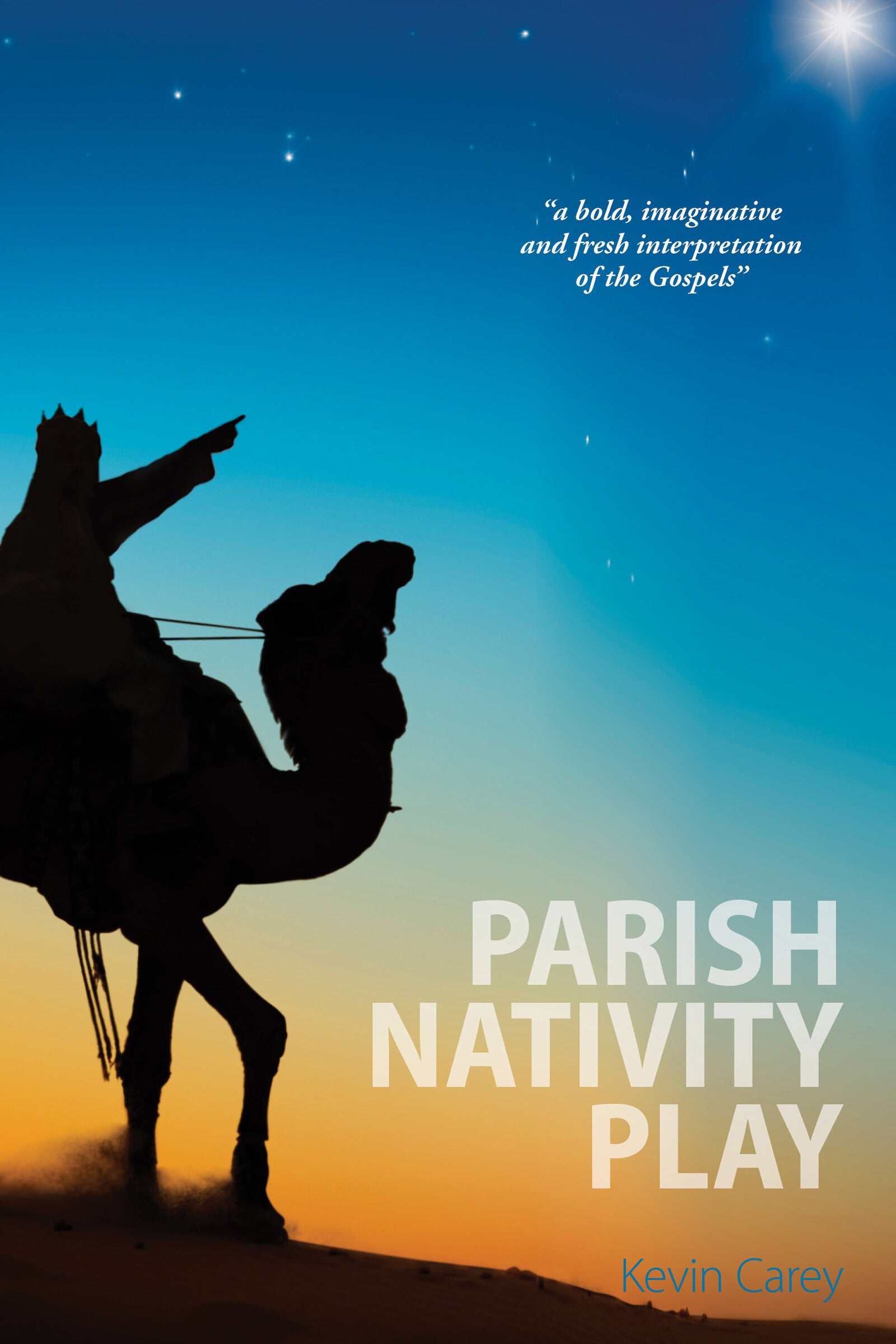Parish Nativity Play
by Kevin Carey

Description
Bring the Christmas narrative to life with this Parish Nativity Play. Kevin Carey’s moving interpretation is suitable for all acting abilities, ages, and experience levels. It can be performed with props and costumes or simply read aloud.
Production Multipacks: five for the price of three – get two free copies for every five copies you add to your cart (discount will be applied automatically at checkout).
By marrying the two Gospel accounts of the Incarnation, supplemented by the author’s imagination, Carey’s nativity play stays as close to the meaning as possible, and yet remains entertaining for both cast and audience alike!
“This is a bold, imaginative and fresh interpretation of the Gospels. It is a pleasure for me to recommend strongly this highly original and ground-breaking Passion Play.” - Professor Sir Colin J. Humphreys, CBE, author of “The Mystery of the Last Supper”
Preface
From a Christian standpoint, of the four major events in human history—the beginning and end of creation (or, as we might more broadly term it, time), and the Incarnation and the Resurrection of Jesus—the event about which we know least is the Incarnation. Science is still groping for a full understanding of the birth and death of time but at least it has created an elegant paradigm. By contrast, there are four different accounts of the Crucifixion, death and Resurrection of Jesus by the four Evangelists and only two of them have anything to say about the Incarnation and, even then, their narratives hardly coincide.
There being such little scriptural material, a serious play about the Incarnation must do what it can to marry the two accounts, supplemented by imagination.
My major points of departure from tradition, and the areas where I have taken the greatest liberty—or, to put it another way, have exercised the greatest imagination to achieve coherence—are in the scenes which involve the wise men. Matthew, somewhat confusingly, reflecting his penchant for duplicates—notably the two donkeys in 21.1–7—says successively in verses 2.1 and 2.2 that the wise men came from the east, saw a star in the east and then followed it to the east. If they travelled towards the star they must have come from west of it, which is the line I have taken by beginning their final journey in Alexandria, where they congregate to make their preparations. Using this device, the men could still have come from the east. Seeing the “star” moving from west to east, “ahead of them . . . until it stopped over the place where the child was” (Matthew 2.9), when the men are either travelling south from Jerusalem to Bethlehem or, in the alternative scenario, travelling north to Nazareth, makes no sense. All one can do is to get as close to the meaning as possible.
I have presented two theories to account for “the star”: one being a planetary conjunction; the other a comet, allowing the wise men to debate the issue. However, as the drama takes place in a miraculous ecology, anything is possible.
There is a long tradition, in contradiction of the popular crib and a great deal of Renaissance art, that these men did not visit Jesus in Bethlehem, in spite of Matthew 2.8–9, but went instead to Nazareth to worship a child perhaps two years of age. The explanation for this is the use of “house” (as opposed to the traditional “stable”) in Matthew 2.11. Joseph would hardly resort to a public inn out of desperation in the town of his tribe as if he had no relations there.
This naturally leads to my second departure from tradition: I understand the Greek word kataluma in Luke 2.7 to mean a “residence”, as it does in Luke 22.11, rather than “inn” which is more usually represented by the Greek pandocheion. Consistent with the narrative of the town of Bethlehem being unusually over-populated because of tax registration, I surmise that the spare room of Joseph’s relative was full, so the young couple were given space in the lower part of the house where the animals were kept at night and so, after the birth, Mary wrapped Jesus in bands of cloth and laid him in the most comfortable place she could find, in the hay-filled animal feeding trough. This, in turn, makes the visit of the wise men to a domestic environment, rather than a stable out-house or a house in Nazareth, much more credible; the price we pay is the loss of the villainous innkeeper and the pathos surrounding the birth of an outcast in an out-house—but Luke, the consummate story teller, is unlikely to have missed the opportunity to extract every last ounce of pathos from such a curious birth-place, instead of which he dismisses the apparent inconvenience in half a line.
If the wise men visit the new-born Jesus in Bethlehem, the traditional 6 January date is not beyond credibility, as Jesus would not have had to return to his family home in Nazareth to be circumcised; this, in turn, allows Jesus to be presented some forty days after his birth before Joseph receives a warning to flee into Egypt. At the end of Matthew’s account the knotty Bethlehem/Nazareth problem is solved by Joseph fearing to return to his native city and opting to settle in Nazareth instead but, of course, this throws the Lucan tax registration scenario into doubt as, if Joseph lived in Bethlehem, he would not have had to travel there.
I have used material from Sura 19 of the Qu’ran in Act 2 Scene 2, and acknowledge its proper status as believed by hundreds of millions to be sacredly inspired Scripture; where it contradicts the New Testament, over the nature of the child, for example, I have taken a Christian standpoint.
In all other respects I have allowed the text, particularly from Luke, to speak for itself. In spite of quite proper doubts about the notion of a census of tax payers and the known dates of Quirinius’s rule (Luke 2.1–2), I have let these and other similar events stand as this, except in respect of the two instances above, is largely a traditional play on the basis that it is theology and not consistency that is crucial, and that unnecessary disturbance would cause unnecessary distraction from my central purpose.
That is not to say that a traditional play must adopt the traditions of later ages. I do not accept, for example, that Jesus was born “In The Bleak Midwinter”, as Christina Rosetti would have it, still experiencing the Little Ice Age whose conclusion some scholars date as late as 1870, and when the Victorians were adopting Germanic Midwinter Solstice customs.
As the purpose of the play is primarily theological, it would be impossible to follow the Jewish custom of not citing the name of God and so there are, if you like, theological anachronisms. Likewise, the Prologue delivered by God and the Epilogue delivered by the Holy Spirit paradoxically advance somewhat complex theological arguments by being somewhat anthropomorphic in the spirit of medieval mystery plays and, indeed, my mind, particularly in writing humorous passages, was never very far from them.
I should also say a word about the use of the term “Jeshua” for the Messiah, which caused some disquiet when I used it in my companion Parish Passion Play. This is not an attempt to be idiosyncratic for the sake of it; apart from the fact that Jeshua is what his contemporaries would have called him, the word provides more flexibility in writing blank verse than “Jesus”.
The dates at the beginning of each scene are not supposed to be scientifically precise but indicate a credible chronology except, of course, when appearing at the head of the Prologue and Epilogue when they might pass as a mild joke. I follow the Jewish custom of calendar dating from sunset to sunset which explains the birth of Jesus on the 25th on the evening of the natural day when the sun rose on the 24th. I am aware of the scholarship which dates the birth of Jesus to 4 BC but this hardly works in a traditional play! It would make a very clumsy play if dates were somehow to be inserted into the dialogue so it will help audiences if they are included in the performance programme.
The play can either be read by participants sitting in a horseshoe and rising to read their lines as indicated, or it can be acted. The text is written so that a reading without actions makes sense and this accounts for the absence of stage directions; for example, when a shepherd touches the new-born child it can be assumed that he is either bending low or kneeling, according to the preference of the director; but he is certainly not standing up straight. The play is written in traditional blank verse because, in my experience, and perhaps counter-intuitively, this form forces the reader subconsciously to place emphasis on the words that require it whereas prose demands a great deal more rehearsal.
The characters of God, Jeshua and the Holy Spirit speak in three-line stanzas, or terces, which symbolise their mutual membership of the Trinity. This form of verse is not easy to deliver and, alone in the play, requires an experienced reader of poetry.
When the term “severally” is used in directions it means that the speakers should select some of the text offered and say it but not in unison.
My intention is that a performance should only require one rehearsal, largely to check the sound system, if one is being used, and to accustom readers to the tempo. The play consists of many very short scenes and there should be no gaps between them so that the momentum is maintained, reflecting the modern techniques of radio and television drama rather than a more ponderous theatrical tradition.
A straight performance will take 75 minutes but some directors may wish to include carols, and it would be a novelty to open the play, instead of closing it, with “We Three Kings”.
Above all, the purpose of the play is to restore Christmas to its proper theological context. If we are simply to make do with Nativity plays for children with their tea-towel head-dresses and tinsel angel wings, they will be put aside like “childish things” (1 Corinthians 13.11) when we grow up, or at least grow older. We can, and should, do better.
Kevin Carey
Advent Sunday 2015
Authors
Kevin Carey (author)

Kevin Carey is one of Sacristy Press’s founding and most prolific authors, writing Christian literature in all major forms: novels, non-fiction, plays and verse. Kevin was an IT consultant between 1997 and his retirement in 2018, specialising in access to technology by people with disabilities, the poor and the elderly....
